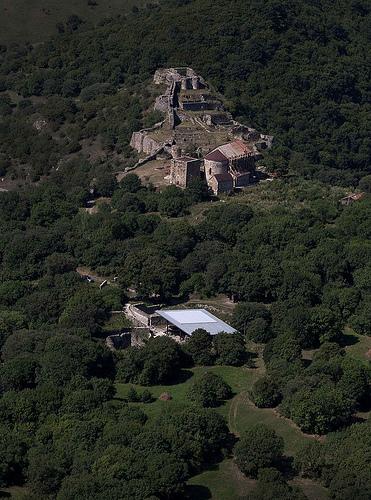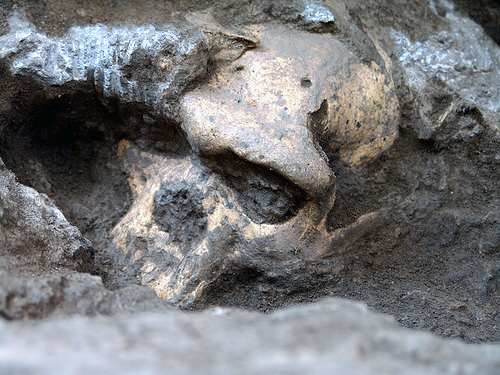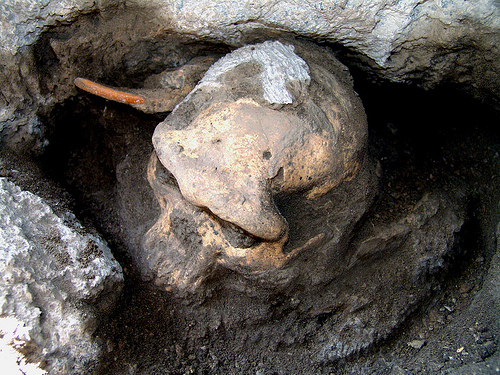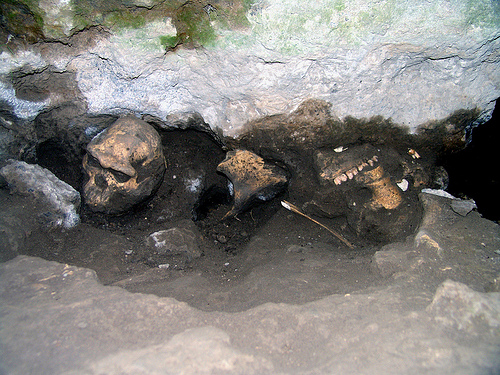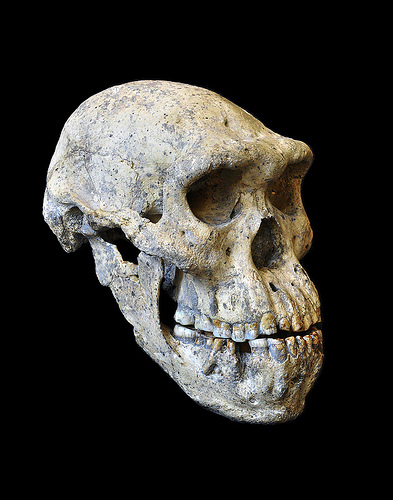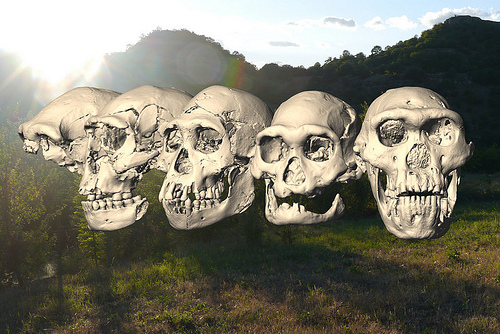
No one could have predicted this.
While excavating among Medieval period ruins in 1983 near the town of Dmanisi in the Republic of Georgia, archaeologists encountered a jaw-dropping find. They had uncovered a partial set of fossilized teeth belonging to a rhinoceros — an ancient type that made its home thousands of miles away in places like present-day Tanzania, Kenya and South Africa.
The scientists were scratching their heads.
It just didn’t fit.
More fossils followed — mammoth, giraffe, saber-toothed cat. Clearly they had opened a door to a time long before anything they had come to expect from their excavations at Dmanisi. They were suddenly digging into a slice of the Early Pleistocene, between 1 million and 2 million years ago—when Europe’s environment was like that seen today in east and southern Africa.
But the excavators’ surprising encounters didn’t stop with animal fossils. Next came stones. Thousands of them. They were clearly shaped with intent, and not by nature. These bits of stone resembled in remarkable detail the kinds of simple stone tools first uncovered by Louis and Mary Leakey during the 1930’s at Olduvai Gorge in Tanzania. This was the very first human tool industry, known as the Oldowan, the advent of which is now generally accepted by scientists to have occurred about 2.6 million years ago.
So, here was the smoking gun. There must have been some form of human here contemporaneous with these ancient animals.
____________________________
Shaking Up the Old Guard
It wasn’t until 1991 that workers at Dmanisi discovered the first direct evidence of a human presence within the Pleistocene layers. It was a fossilized mandible (the lower jaw), and it appeared to be human—but quite different from a modern human mandible. It was more like what scientists had been finding for decades in East and South Africa—fossils of what paleoanthropologists know to be some of the earliest members of our kind—genus Homo—human ancestors that lived between 1 million and 2 million years ago. Geographically, this fossil appeared to be several thousands of miles off course.
Even more remarkable finds were uncovered in 1999 — two similar skulls emerged. Two years later, a third. Then a fourth. One of the skulls had no teeth, only gums. Further examination showed that the individual had suffered an illness and had been toothless for about two years prior to death. How could such an individual survive in the comparatively harsher life conditions that must have existed almost 2 million years ago? Was this person cared for in sickness, as we do our fellow humans today?
These new finds were turning some widely accepted theories of human evolution on their heads.
“The prevailing view was that humans did not leave Africa until about 1 million years ago,” said David Lordkipanidze, paleoanthropologist and Director of the Georgian National Museum.* He has been directing the excavations at Dmanisi for decades. He and his colleagues have dated the new Homo fossils to about 1.8 million years ago using the latest dating technologies. Moreover, the morphology (physical characteristics) of the Dmanisi fossils seemed to be clearly ancestral to the later Homo erectus human species that had long been thought the first global colonizers. The Dmanisi specimens exhibited affinities to the earlier Homo habilis and Homo ergaster finds uncovered at African locations. And the stone tools were Oldowan — the simplest industry — not the more sophisticated Acheulean handaxe technology that at least some scientists contended was required to enable early humans to exit their African environment and survive as a global species.
In the time-honored fashion, Lordkipanidze’s discoveries were immediately met with controversy. “One group of scientists accepted [our interpretation], but mostly people were skeptical,” he said.*
With time, however, his discoveries at Dmanisi have joined the “who’s who” of fossil humans, and the research he and his team are doing today stands at the cutting edge of work in human evolution. Dmanisi is widely regarded as one of the world’s earliest early Homo sites outside of Africa.
But, Lordkipanidze and his colleagues were not through shaking things up in the world of human evolution.
_________________________________________________________________________
Aerial view of the Dmanisi excavation site (foreground) and medieval town. Courtesy Fernando Javier Urquijo
_______________________________________________________________________________________________________
Skull 5
While excavating at Dmanisi in 2005, Lordkipanidze and his team uncovered yet another remarkably well-preserved early Homo fossil. Designated as specimen ‘D4500′, it turned out to be the matching cranium to another fossil find uncovered 5 years earlier — a complete mandible they designated ‘D2600’. These two fossils were discovered alongside the remains of the four other early Homo fossil skulls, animal fossils, and simple stone tools. Designated Skull 5, the new cranium together with its mandible display a relatively small braincase with a long face and large teeth. Other similar early Homo fossils, all found in African contexts, are either incomplete, or adolescent or younger individuals. According to Lordkipanidze and his associates, this new find constituted “the most complete adult skull known from Early Pleistocene Homo.“** Moreover, like some of the other finds, it was associated with other parts of the body that exhibited characteristics akin to Homo erectus body engineering, which closely approximates that of modern human morphology. In other words, this species had a very human-like body.
_________________________________________________________________________
The Dmanisi early Homo cranium (D4500) in situ. Courtesy Georgian National Museum
_________________________________________________________________________
The Dmanisi D4500 early Homo cranium and a large rodent tooth in situ. Associated fauna, such as the tooth from a rodent species that lived 1.8 million years ago, helped to date the find. Courtesy Georgian National Museum
__________________________________________________________________________
The Dmanisi D4500 early Homo cranium and ancient herbivore fossil remains in situ. Courtesy Georgian National Museum
_______________________________________________________________________________________________________
The complete Skull 5. Courtesy Guram Bumbiashvili, Georgian National Museum
_________________________________________________________________________
Skull 5 was another first. But the biggest revelation came not with the latest fossil, but with what the fossils collectively had to say about human evolution.
Now, with fossil finds that represented five distinct individuals, it was the first time that such an assembly of Early Homo fossils were found together within the same time and space context. No other site, in Africa or elsewhere, could boast of such a collection. The Dmanisi discoveries meant that scientists could study a range of variation in human species within the context of one place and time range, a relative mother lode of information that could potentially clarify, and perhaps even revolutionize, how we see these earliest of Homo human ancestors.
The researchers set to work. And the result of their study was startling. Lordkipanidze and his colleagues summarize it well in the following words in their recent report published in Science:
Geometric morphometric analysis and re-sampling statistics show that craniomandibular shape variation among the Dmanisi hominids is congruent with patterns and ranges of variation in chimpanzee and bonobo demes [a population of one species](Pan troglodytes troglodytes, P. t. verus, P. t. schweinfurthii, and P. paniscus) and in a global sample of H. sapiens. Within all groups, variation in cranial shape is mainly due to interindividual differences in size and orientation of the face relative to the braincase. The Dmanisi sample, including skull 5, thus represents normal within-deme variation, ranging from small-faced relatively orthognathic (typically female and/or subadult) individuals to large-faced relatively prognathic (typically male) individuals.**
In other words, after examining the remains, the research team concluded that the differences among these fossils vary no more than the differences between five modern humans or five chimpanzees.
“Thanks to the relatively large Dmanisi sample, we see a lot of variation,” said Christoph Zollikofer from the Anthropological Institute and Museum in Zurich, Switzerland—a co-author of the Science report. “Had the braincase and the face of Skull 5 been found as separate fossils at different sites in Africa, they might have been attributed to different species.”
Historically, variations among Homo fossil finds in Africa and Asia have also been found, but these differences have never been found within the same spatial and time period context, and thus scientists have classified the various finds as belonging to separate species. But now, according to Lordkipanidze and his colleagues, what has previously been thought to be separate ancient human species — Homo erectus, Homo habilis, Homo rudolfensis, and Homo ergaster, for example — may actually be variations or sub-species of one and the same species.
The upshot: Researchers need to re-adjust their thinking when determining how early Homo fossils are classified.
_________________________________________________________________________
Dmanisi Skulls 1-5 (left to right), showing the individual variations, and a Dmanisi landscape. Courtesy M. Ponce de León and Ch. Zollikofer, University of Zurich, Switzerland
_____________________________________________________________________________________________________________________
The Erectus Ascendancy
The findings at Dmanisi compelled the researchers to propose a major overhaul of how these early Homo fossils fit into the larger scheme of human evolution, including the emergence of human ancestors from their African homelands. As Lordkipanidze et al. report:
When seen from the Dmanisi perspective, morphological diversity in the African fossil Homo record around 1.8 Ma probably reflects variation between demes of a single evolving lineage [emphasis added], which is appropriately named H. erectus……Specimens previously attributed to H. ergaster are thus sensibly classified as a chronosubspecies, H. erectus ergaster. The Dmanisi population probably originated from an Early Pleistocene expansion of the H. erectus lineage from Africa, so it is sensibly placed within H. e. ergaster and formally designated as H. e. e. georgicus to denote the geographic location of this deme.**
By this thinking, what Louis and Mary Leakey first uncovered at Olduvai Gorge, Tanzania in 1960 would not be Homo habilis, but Homo erectus habilis, what Kamoya Kimeu and Alan Walker discovered at Lake Turkana, Kenya in 1984 would not simply be Homo ergaster (the famous “Turkana Boy”), but Homo erectus ergaster, and what Bernard Ngeneo found at Koobi Fora on the east side of Lake Turkana in 1972 was not Homo rudolfensis, it was Homo erectus rudolfensis.
Most significantly, the evidence at Dmanisi, given its location and place in time, also implies something that challenges a long-standing paradigm in a big way: It was not the bigger-brained, bigger-bodied Homo erectus, with the more sophisticated Acheulean stone tools, that first ventured out of their native African comfort zone — it was the smaller-brained, smaller-bodied ones with the simple tools. And the exit out of Africa happened significantly earlier than previously thought. Scientists, these researchers suggest, will need to reconsider the elements required for early humans to become a global species.
Paleoanthropology, however, like many other scientific fields, has proven to be a science where theories come and go. Lordkipanidze and his research colleagues would likely be among the first to admit that their conclusions from Dmanisi are wide open to debate and further testing through future finds and research, at Dmanisi and elsewhere.
“Every year we are finding more and more,” says Lordkipanidze, “and we have excavated only 7 percent of the site.”*
That statement was made a few years ago. The percentage has gone up since then.
__________________
* Lordkipanidze, David, “The First Humans Out of Africa”. Posted March 2012. TEDvideo, 15:27. http://www.youtube.com/watch?v=dC0gdpVS4uM
** David Lordkipanidze, et al., A Complete Skull from Dmanisi, Georgia, and the Evolutionary Biology of Early Homo, Science 342:326-331, 2013.
Cover Photo, Top Left: The five skulls of Dmanisi, against the backdrop of the Dmanisi area. Courtesy Marcia Ponce de León and Christoph Zollikofer, University of Zurich, Switzerland
________________________________________________________________________________________________________
Read about the most fascinating discoveries with a premium subscription to Popular Archaeology Magazine. Find out what Popular Archaeology Magazine is all about. AND MORE:
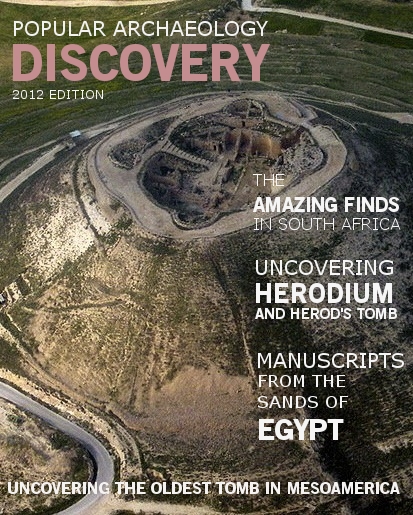 Popular Archaeology’s annual Discovery edition is a selection of the best stories published in Popular Archaeology Magazine in past issues, with an emphasis on some of the most significant, groundbreaking, or fascinating discoveries in the fields of archaeology and paleoanthropology and related fields. At least some of the articles have been updated or revised specifically for the Discovery edition. We can confidently say that there is no other single issue of an archaeology-related magazine, paper print or online, that contains as much major feature article content as this one. The latest issue, volume 2, has just been released. Go to the Discovery edition page for more information.
Popular Archaeology’s annual Discovery edition is a selection of the best stories published in Popular Archaeology Magazine in past issues, with an emphasis on some of the most significant, groundbreaking, or fascinating discoveries in the fields of archaeology and paleoanthropology and related fields. At least some of the articles have been updated or revised specifically for the Discovery edition. We can confidently say that there is no other single issue of an archaeology-related magazine, paper print or online, that contains as much major feature article content as this one. The latest issue, volume 2, has just been released. Go to the Discovery edition page for more information.
Subscription Price: A very affordable $5.75 for those who are not already premium subscribers of Popular Archaeology Magazine (It is FREE for premium subscribers to Popular Archaeology). Premium subscribers should email [email protected] and request the special coupon code. Or, for the e-Book version, it can be purchased for only $3.99 at Amazon.com.

